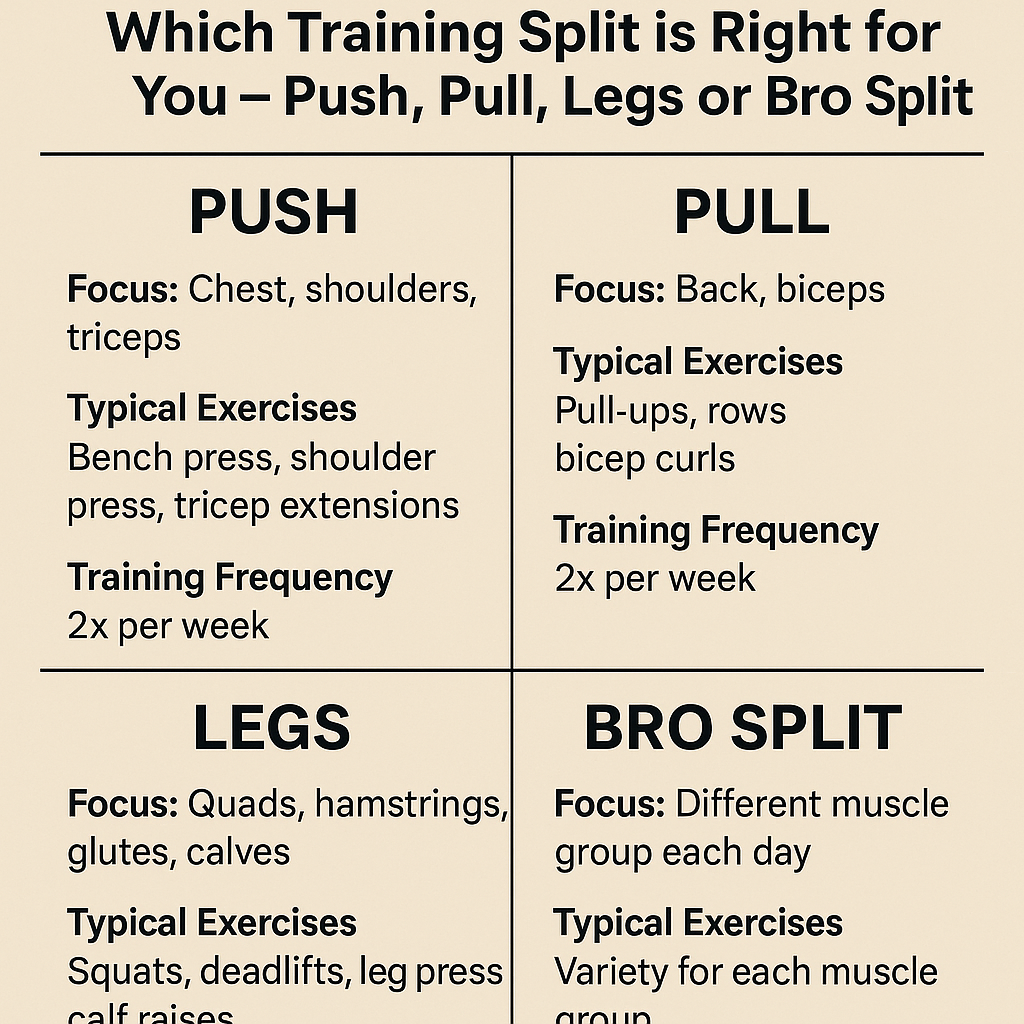Know The Difference: Which Training Split is Right for You – Push, Pull, Legs or Bro Split?
Discover the pros, cons, and key differences between the Push Pull Legs and Bro Split to decide which training split is right for you and your fitness goals.
Introduction to Training Splits
What is a training split?
A training split is a structured workout plan that divides your exercises across different days, focusing on specific muscle groups or movement patterns. It helps organize your training, ensuring optimal recovery while maximizing performance.
Why training splits matter in workout planning
Effective splits improve consistency, avoid overtraining, and enhance results by allowing you to target each muscle group more effectively. Whether you’re aiming to build muscle, improve endurance, or lose fat, your split should align with your goals.
Overview of the Push, Pull, Legs Split (PPL)
What is the Push, Pull, Legs split?
The Push Pull Legs Split divides workouts by movement type:
- Push days: Chest, shoulders, and triceps
- Pull days: Back and biceps
- Leg days: Quads, hamstrings, glutes, and calves
Typical weekly schedule for PPL
| Day | Workout |
| Monday | Push |
| Tuesday | Pull |
| Wednesday | Legs |
| Thursday | Rest or repeat |
| Friday | Push |
| Saturday | Pull |
| Sunday | Legs or rest |
Benefits of the PPL split
- Balanced volume and intensity
- Great for progressive overload
- Ideal for both muscle growth and strength
- Efficient recovery built into schedule
In-Depth Look at the Bro Split
What is the Bro Split?
The Bro Split targets one muscle group per day. Popular among bodybuilders, it allows deep focus on a single area with high volume.
Typical Bro Split workout schedule
| Day | Muscle Group |
| Monday | Chest |
| Tuesday | Back |
| Wednesday | Shoulders |
| Thursday | Arms |
| Friday | Legs |
| Saturday | Rest or Abs/Cardio |
| Sunday | Rest |
Benefits of the Bro Split
- Full focus on one muscle group
- Reduces overall fatigue
- High volume encourages hypertrophy
- Easy to follow and schedule
Key Differences Between Push, Pull, Legs and Bro Split
Training frequency
PPL typically hits each muscle twice a week; Bro Split hits each once.
Muscle group targeting
Bro Split isolates muscles more; PPL trains muscle groups together by movement type.
Recovery time and muscle fatigue
PPL allows better recovery between similar muscles. Bro Split gives entire week recovery for a muscle.
Flexibility and lifestyle fit
Bro Split suits those with a 5-day gym habit. PPL is more flexible and adjustable for busy schedules.
Who Should Choose the Push, Pull, Legs Split?
Ideal for intermediate to advanced lifters
If you’re used to training 4–6 days weekly and want full-body development, PPL works best.
Best for hypertrophy and strength gains
This split maximizes workload across muscle groups, perfect for gains in size and strength.
Who Should Choose the Bro Split?
Best for beginners or casual gym-goers
Beginners can benefit from the simplicity and focus of one group per day.
Emphasis on volume and muscle isolation
Great for those looking to sculpt and isolate specific muscles.
Pros and Cons of the Push, Pull, Legs Split
Pros
- Efficient use of time
- Allows for full-body engagement
- Flexible rest options
Cons
- Can be demanding
- May overlap sore muscles if rest isn’t planned
Pros and Cons of the Bro Split
Pros
- Simpler planning
- Intense muscle focus
- Great for aesthetics
Cons
- Long recovery gaps per muscle
- Missed days can disrupt the plan
How to Transition Between Splits
Factors to consider
Switching between PPL and Bro Split—or vice versa—should be based on your goals, schedule, and current progress. If you’re plateauing or feeling fatigued, it may be time to explore a new split.
Making a gradual switch
Transition slowly by incorporating elements of the new split into your current routine. For example, start replacing one or two Bro Split days with PPL structure before fully committing.
Common Mistakes When Choosing a Split
Overtraining
Without proper rest, muscles can’t recover. PPL especially can lead to overtraining if you ignore rest days or do too much volume.
Lack of consistency
Consistency is key. The best split won’t help if you’re inconsistent. Choose a routine you can stick with for at least 8–12 weeks.
Ignoring recovery needs
Sleep, hydration, and nutrition matter just as much as your workouts. Many lifters overlook these, especially when switching routines.
Sample Weekly Workout Plan: Push, Pull, Legs
Here’s an example of a 6-day PPL schedule:
| Day | Workout Focus | Sample Exercises |
| Monday | Push | Bench press, overhead press, tricep dips |
| Tuesday | Pull | Deadlift, pull-ups, barbell rows |
| Wednesday | Legs | Squats, lunges, leg press |
| Thursday | Push | Incline dumbbell press, lateral raises |
| Friday | Pull | T-bar row, face pulls, bicep curls |
| Saturday | Legs | Romanian deadlifts, calf raises |
| Sunday | Rest | — |
Sample Weekly Workout Plan: Bro Split
Here’s a standard 5-day Bro Split schedule:
| Day | Muscle Group | Sample Exercises |
| Monday | Chest | Bench press, cable flys, chest dips |
| Tuesday | Back | Deadlift, pull-ups, single-arm rows |
| Wednesday | Shoulders | Overhead press, lateral raises, shrugs |
| Thursday | Arms | Barbell curls, skull crushers, hammer curls |
| Friday | Legs | Squats, leg curls, calf raises |
| Saturday | Optional Cardio | HIIT or steady-state cardio |
| Sunday | Rest | — |
Nutrition and Recovery for Both Splits
Macronutrients for muscle recovery
Regardless of the split, your body needs fuel. Aim for:
- Protein: 1.6–2.2g per kg of body weight daily
- Carbohydrates: For energy and recovery
- Fats: Essential for hormone regulation
A balanced post-workout meal within 30–60 minutes is vital.
Importance of sleep and rest days
Sleep is when muscles repair. Aim for 7–9 hours per night. Incorporate at least 1–2 full rest days weekly, especially with the PPL split.
Role of Cardio in Both Splits
How to integrate cardio with weight training
Cardio should complement, not compete with, your lifting. You can:
- Do cardio on rest days
- Perform low-intensity cardio post-workout
Fat loss vs. muscle gain goals
If you’re cutting, prioritize cardio but avoid excess volume. For bulking, limit cardio to avoid interfering with gains.
Tracking Progress and Making Adjustments
Using logs and apps
Use fitness apps or journals to track sets, reps, and weight. Tools like Strong or Fitbod can help tailor workouts over time.
Listening to your body
Adapt your split if you’re feeling burned out, injured, or no longer progressing. Adjust intensity, volume, or even your split entirely.
Expert Opinions on Training Splits
Insights from fitness coaches and bodybuilders
Most experts agree there’s no “one-size-fits-all” split. According to Jeff Nippard, a popular evidence-based fitness coach, the Push, Pull, Legs split is optimal for hypertrophy, while the Bro Split remains viable for those focused on muscle definition and flexibility.
FAQs: Which Training Split is Right for You – Push, Pull, Legs or Bro Split?
1. Which split is better for building muscle faster?
The PPL split generally offers more frequent stimulation, which may lead to faster hypertrophy with proper recovery and nutrition.
2. Can beginners use the PPL split?
Yes, but beginners might benefit more from full-body or Bro Splits before transitioning to PPL.
3. Is the Bro Split outdated?
No, it’s still widely used by bodybuilders and casual lifters. It’s simple, effective, and focused.
4. Can I mix both splits in my routine?
Yes, many lifters combine both. For example, using a Bro Split during a deload week within a PPL framework.
5. How many days per week do I need to commit to see results?
Consistency is key. A minimum of 3–4 days per week is needed for PPL, while Bro Split works well with a 5-day plan.
6. What if I miss a day in either split?
With PPL, you can simply pick up where you left off. Bro Split may require rescheduling or skipping that muscle group for the week.
Conclusion: Making the Right Choice for Your Fitness Goals
Choosing the right training split depends on your experience level, goals, lifestyle, and preferences. The Push, Pull, Legs split is excellent for maximizing muscle gains and balancing recovery, ideal for those who train 4–6 days a week. The Bro Split offers simplicity and intense focus on each muscle group, suitable for beginners or those who prefer isolated training.
Experiment, stay consistent, track your progress, and be willing to adapt. That’s how you’ll truly find out which training split is right for you – Push, Pull, Legs or Bro Split?
External Resource:
For a science-backed breakdown of training splits, check out Stronger by Science.
4 Benefits Of Intra-Workout Supplements On Performance
Carb Cycling to Burn Fat and Maintain Muscle – A Proven Strategy
New Research: Creatine Boosts Memory by 31% & Processing Speed by 51%!
Follow Us On




